
Bryozoa are a phylum of simple, aquatic invertebrate animals, nearly all living in sedentary colonies. Typically about 0.5 millimetres long, they have a special feeding structure called a lophophore, a "crown" of tentacles used for filter feeding. Most marine bryozoans live in tropical waters, but a few are found in oceanic trenches and polar waters. The bryozoans are classified as the marine bryozoans (Stenolaemata), freshwater bryozoans (Phylactolaemata), and mostly-marine bryozoans (Gymnolaemata), a few members of which prefer brackish water. 5,869 living species are known. Originally all of the crown group Bryozoa were colonial, but as an adaptation to a mesopsammal life or to deep‐sea habitats, secondarily solitary forms have since evolved. Solitary species has been described in four genera; Aethozooides, Aethozoon, Franzenella and Monobryozoon). The latter having a statocyst‐like organ with a supposed excretory function.

The Ordovician is a geologic period and system, the second of six periods of the Paleozoic Era. The Ordovician spans 41.6 million years from the end of the Cambrian Period 485.4 Ma to the start of the Silurian Period 443.8 Ma.
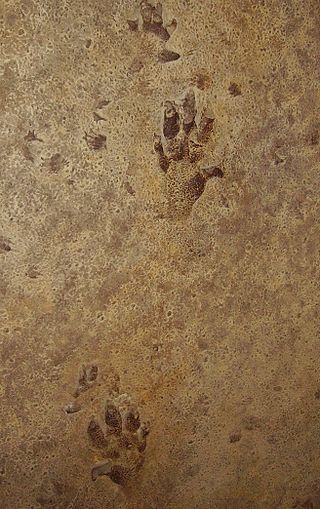
A trace fossil, also known as an ichnofossil, is a fossil record of biological activity by lifeforms but not the preserved remains of the organism itself. Trace fossils contrast with body fossils, which are the fossilized remains of parts of organisms' bodies, usually altered by later chemical activity or mineralization. The study of such trace fossils is ichnology and is the work of ichnologists.
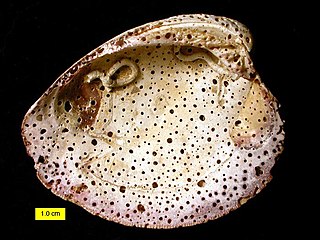
Bioerosion describes the breakdown of hard ocean substrates – and less often terrestrial substrates – by living organisms. Marine bioerosion can be caused by mollusks, polychaete worms, phoronids, sponges, crustaceans, echinoids, and fish; it can occur on coastlines, on coral reefs, and on ships; its mechanisms include biotic boring, drilling, rasping, and scraping. On dry land, bioerosion is typically performed by pioneer plants or plant-like organisms such as lichen, and mostly chemical or mechanical in nature.

Stromatoporoidea is an extinct clade of sea sponges common in the fossil record from the Middle Ordovician to the Late Devonian. They can be characterized by their densely layered calcite skeletons lacking spicules. Stromatoporoids were among the most abundant and important reef-builders of their time, living close together in flat biostromes or elevated bioherms on soft tropical carbonate platforms.

Carbonate hardgrounds are surfaces of synsedimentarily cemented carbonate layers that have been exposed on the seafloor. A hardground is essentially, then, a lithified seafloor. Ancient hardgrounds are found in limestone sequences and distinguished from later-lithified sediments by evidence of exposure to normal marine waters. This evidence can consist of encrusting marine organisms, borings of organisms produced through bioerosion, early marine calcite cements, or extensive surfaces mineralized by iron oxides or calcium phosphates. Modern hardgrounds are usually detected by sounding in shallow water or through remote sensing techniques like side-scan sonar.

Trypanites is a narrow, cylindrical, unbranched boring which is one of the most common trace fossils in hard substrates such as rocks, carbonate hardgrounds and shells. It appears first in the Lower Cambrian, was very prominent in the Ordovician Bioerosion Revolution, and is still commonly formed today. Trypanites is almost always found in calcareous substrates, most likely because the excavating organism used an acid or other chemical agent to dissolve the calcium carbonate. Trypanites is common in the Ordovician and Silurian hardgrounds of Baltica.

Cornulitida is an extinct order of encrusting animals from class Tentaculita, which were common around the globe in the Ordovician to Devonian oceans, and survived until the Carboniferous. Organisms that may be the oldest cornulitids have been found in Cambrian sediments of Jordan.
Brutalichnus is an ichnogenus. A case study from the Miocene of the Czech Republic found that Brutalichnus and two other ichnogenera have evidence of biting and gnawing traces on reptilian and mammalian bones. Brutalichnus contains one ichnospecies, Brutalichnusbrutalis. The ichnogenera Machichnus and Nihilichnus were described in the same paper.
Machichnus is an ichnogenus. It was erected by Mikuláš et al. (2006) for shallow, thin, discrete, parallel to subparallel, smooth-bottomed scratches, occurring on bone tissue in small groups or series. According to modern analogues, the series of scratches represent marks of teeth of carnivorous or scavenging reptilians and mammals. Such traces are quite frequent in the fossil record since the mid-Mesozoic, but they have seldom been described in detail.
Nihilichnus is an ichnogenus of trace fossil. It was first described from bite traces in 2006. The ichnogenus originally contained two ichnospecies, Nihilichnus nihilicus and Nihilichnus mortalis. The ichnogenera Brutalichnus and Machichnus were described in the same paper.

Teredolites is an ichnogenus of trace fossil, characterized by borings in substrates such as wood or amber.
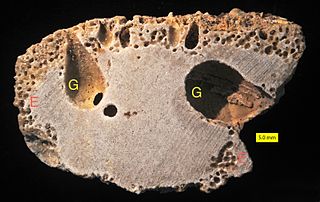
Gastrochaenolites is a trace fossil formed as a clavate (club-shaped) boring in a hard substrate such as a shell, rock or carbonate hardground. The aperture of the boring is narrower than the main chamber and may be circular, oval, or dumb-bell shaped. Gastrochaenolites is most commonly attributed to bioeroding bivalves such as Lithophaga and Gastrochaena. The fossil ranges from the Ordovician to the Recent. The first Lower Jurassic Gastrochaenolites ichnospecies is Gastrochaenolites messisbugi Bassi, Posenato, Nebelsick, 2017. This is the first record of boreholes and their producers in one of the larger bivalves of the globally occurring Lithiotis fauna which is a unique facies in the Lower Jurassic Tethys and Panthalassa.
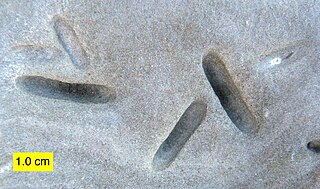
Petroxestes is a shallow, elongate boring originally found excavated in carbonate skeletons and hardgrounds of the Upper Ordovician of North America. These Ordovician borings were likely made by the mytilacean bivalve Corallidomus as it ground a shallow groove in the substrate to maintain its feeding position. They are thus the earliest known bivalve borings. Petroxestes was later described from the Lower Silurian of Anticosti Island (Canada). and the Miocene of the Caribbean.

Rogerella is a small pouch-shaped boring with a slit-like aperture currently produced by acrothoracican barnacles. These crustaceans extrude their legs upwards through the opening for filter-feeding. They are known in the fossil record as borings in carbonate substrates from the Devonian to the Recent.

Entobia is a trace fossil in a hard substrate formed by sponges as a branching network of galleries, often with regular enlargements termed chambers. Apertural canals connect the outer surface of the substrate to the chambers and galleries so the sponge can channel water through its tissues for filter feeding. The fossil ranges from the Devonian to the Recent.

Osprioneides is an ichnogenus of unbranched, elongate borings in lithic substrate with oval cross−section, single−entrance and straight, curved or irregular course. Osprioneides kampto Beuck and Wisshak, 2008 is the largest known Palaeozoic boring trace. It occurs in the Ordovician and Silurian (Wenlock) of Baltica. The borings are up to 120 mm long measuring 5–17 mm in diameter. The distribution of Osprioneides is more environmentally limited than that of Trypanites in the Silurian of Saaremaa, Estonia (Baltica). Osprioneides probably occurred only in large hard substrates of relatively deepwater muddy bottom open shelf environments. Osprioneides were relatively rare, as compared to Trypanites-Palaeosabella borings in the Wenlock of Saaremaa.
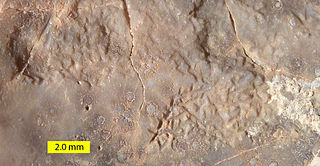
Gnathichnus is a trace fossil on a hard substrate formed by regular echinoids as they scraped the surface with their five-toothed Aristotle's Lantern feeding structures.
Tremichnus is an ichnogenus or trace fossil. It is an embedment structure formed by an organism that inhibited growth of the crinoid host stereom. The most common endobiotic symbiont in Paleozoic crinoids is Tremichnus
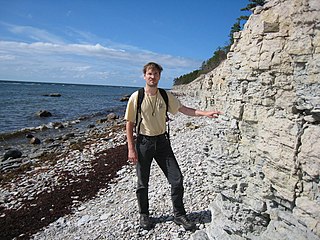
Olev Vinn is an Estonian paleobiologist and paleontologist.















